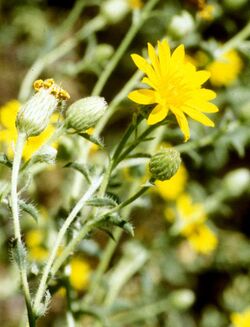Biology:Heterotheca
| Heterotheca | |
|---|---|

| |
| Heterotheca shevockii | |
| Scientific classification | |
| Kingdom: | Plantae |
| Clade: | Tracheophytes |
| Clade: | Angiosperms |
| Clade: | Eudicots |
| Clade: | Asterids |
| Order: | Asterales |
| Family: | Asteraceae |
| Subfamily: | Asteroideae |
| Tribe: | Astereae |
| Subtribe: | Chrysopsidinae |
| Genus: | Heterotheca Cass. |
| Type species | |
| Heterotheca lamarckii[1] syn of H. subaxillaris[2] Cass.
| |
| Synonyms[3][4] | |
| |
Heterotheca (common names goldenasters, camphorweed, or telegraph weed)[5] is a genus of North American plants in the family Asteraceae.[1][6]
Etymology
Heterotheca comes from Ancient Greek ἕτερος Script error: The function "transl" does not exist. "other, different" and θήκη Script error: The function "transl" does not exist. "case, chest", and refers to the fact that, in some species in the genus, the cypselae (achenes containing seed) of the disk and ray florets have different shapes.[5][7]
Etymology: The genus “Heterotheca” (Heterothe'ca:) is derived from the Greek heteros, “different,” and theke, “ovary,” from the unlike cypselas of the ray and disk florets.
Description, biology
These are annual and perennial herbs bearing daisy-like flower heads with yellow disc florets and usually yellow ray florets, associated with mesic to xeric habitats across North America. Several species now included in Heterotheca were previously classified in the genus Chrysopsis[3][5]
Heterotheca species are often used as food plants by the larvae of some Lepidoptera species including Schinia lynx, Schinia nubila and Schinia saturata (all of which have been recorded on Heterotheca subaxillaris).
Chemistry
The leaf volatiles from which the name "camphorweed" is derived include camphor, but as a minor constituent (less than 2%); of the 41 documented volatiles in a study of Heterotheca subaxillaris, for example, caryophyllene, pinene, borneol, myrcene, and limonene each comprised over 5% of the total.[8]
Species
- Heterotheca barbata (Rydb.) Semple - Spokane golden aster - Washington (state) Idaho
- Heterotheca brandegeei (B.L.Rob. & Greenm.) Semple - northern Baja California
- Heterotheca camporum (Greene) Shinners - Arkansas Missouri Iowa Illinois Ohio Michigan Kentucky Tennessee Mississippi Alabama Georgia Virginia North Carolina New Jersey
- Heterotheca canescens (DC.) Shinners - Nuevo León, Texas New Mexico Oklahoma Colorado Kansas Missouri Iowa
- Heterotheca fastigiata (Greene) V.L.Harms - California
- Heterotheca fulcrata (Greene) Shinners - Coahuila, Tamaulipas, Arizona New Mexico Texas Nevada Utah Colorado Wyoming Idaho
- Heterotheca grandiflora - Telegraphweed - Baja California, California Arizona Nevada Utah
- Heterotheca gypsophila B.L.Turner - Nuevo León
- Heterotheca hartmanii G.L.Nesom - Colorado Wyoming
- Heterotheca inuloides Cass. - Mexican arnica - from Nuevo León to Oaxaca
- Heterotheca jonesii (S.F.Blake) S.L.Welsh & N.D.Atwood - Utah
- Heterotheca leptoglossa DC. - Guanajuato, Chihuahua, Sonora, Sinaloa, Jalisco, San Luis Potosí
- Heterotheca marginata Semple - Arizona
- Heterotheca mexicana V.L.Harms ex B.L.Turner - Durango
- Heterotheca monarchensis D.A.York, Shevock & Semple - monarch golden aster - Fresno County in California
- Heterotheca mucronata V.L.Harms ex B.L.Turner - Nuevo León, Coahuila, Tamaulipas
- Heterotheca oregona (Nutt.) Shinners
- Heterotheca pumila (Greene) Semple - Colorado Wyoming Utah New Mexico
- Heterotheca rutteri (Rothr.) Shinners - Sonora, Arizona
- Heterotheca sessiliflora (Nutt.) Shinners - Sessileflower false golden aster - Baja California, California
- Heterotheca shevockii (Semple) Semple - Kern Canyon false golden aster - Kern County in California
- Heterotheca stenophylla (A.Gray) Shinners - Texas New Mexico Oklahoma Colorado Wyoming Kansas Nebraska South Dakota Iowa Minnesota
- Heterotheca subaxillaris (Lam.) Britton & Rusby - Camphorweed, camphor weed, false goldenaster[7] - widespread from Belize to California , South Dakota, + Massachusetts
- Heterotheca villosa (Pursh) Shinners
- Heterotheca viscida (A.Gray) V.L.Harms - Arizona New Mexico Texas
- Heterotheca zionensis Semple - Zion golden aster - Arizona New Mexico Texas Utah Idaho Wyoming
Formerly included
Many species have been included in Heterotheca at various times in the past, but now regarded as more suitable for other genera. The most common of these is Chrysopsis, but others include Aster Bradburia Osbertia Munnozia Pityopsis + Tomentaurum.[3]
References
- ↑ 1.0 1.1 "Heterotheca", Tropicos, Missouri Botanical Garden, http://www.tropicos.org/NameSearch.aspx?projectid=&name=Heterotheca
- ↑ "Heterotheca". The Plant List. Royal Botanic Gardens (Kew). http://www.theplantlist.org/tpl1.1/search?q=Heterotheca.
- ↑ 3.0 3.1 3.2 3.3 Flann, C (ed) 2009+ Global Compositae Checklist
- ↑ The Plant List, search for Heterotheca
- ↑ 5.0 5.1 5.2 Semple, John C. (2006), "Heterotheca", in Flora of North America Editorial Committee, Flora of North America North of Mexico (FNA), 20, New York and Oxford, http://www.efloras.org/florataxon.aspx?flora_id=1&taxon_id=115371, retrieved 16 July 2016
- ↑ Cassini, Alexandre Henri Gabriel de. 1817. Bulletin des Sciences, par la Societe Philomatique 1817: 137
- ↑ 7.0 7.1 C. Williamson, Gerald (2016). "US Wildflower - Camphorweed, Camphor Weed, False Goldenaster - Heterotheca subaxillaris". http://uswildflowers.com/detail.php?SName=Heterotheca%20subaxillaris.
- ↑ Lincoln, D.E.; Lawrence, B.M. (1984). "The volatile constituents of camphorweed, Heterotheca subaxillaris". Phytochemistry 23 (4): 933–934. doi:10.1016/S0031-9422(00)85073-6.
- ↑ "Heterotheca", County-level distribution maps from the North American Plant Atlas (NAPA) (Biota of North America Program (BONAP)), 2014, http://bonap.net/NAPA/TaxonMaps/Genus/County/Heterotheca
External links
- Jepson Manual Treatment: Heterotheca
- "Heterotheca". Integrated Taxonomic Information System. https://www.itis.gov/servlet/SingleRpt/SingleRpt?search_topic=TSN&search_value=37652.
Wikidata ☰ Q970748 entry
 |

